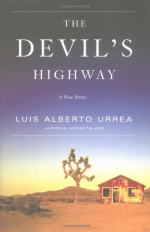
|
| Name: _________________________ | Period: ___________________ |
This test consists of 15 multiple choice questions and 5 short answer questions.
Multiple Choice Questions
1. Who was Jesus AKA Mendez AKA Rooster Boy?
(a) A walker.
(b) The third Cercas brother.
(c) A Coyote.
(d) A rogue Border Patrol agent.
2. Who was Toribio Romo?
(a) Don Moi's right hand man.
(b) The patron saint of undocumented immigrants.
(c) An old soccer coach from Chicago.
(d) The inventor of foam shoes.
3. Why do Border Patrol agents create "drags" (28) running east-west along the desert?
(a) To reduce glare from the setting sun.
(b) To keep the desert sand looking nice and smooth.
(c) To fill time on long, boring days.
(d) To force north-bound border crossers to leave tracks.
4. What state were the walkers discovered in?
(a) Arizona.
(b) Ohio.
(c) Florida.
(d) Oklahoma.
5. What name is initially ascribed to all of the men who died on the journey described within the book?
(a) Jim Drought.
(b) John Doe.
(c) Juan Toledo.
(d) Bob Dole.
6. What name does Urrea use for the Border Patrol agent who discovered the walkers?
(a) Melchior Diaz.
(b) Pancho Villa.
(c) Mike F.
(d) Ofelia Zepeda.
7. What desert vegetation did the walkers try to eat for hydration?
(a) Cactus.
(b) Bell peppers.
(c) Tumble weeds.
(d) Creosote.
8. What hidden tool does Urrea describe that allows Border Patrol agents to secretly track the movements of border crossers?
(a) Camouflaged bloodhounds.
(b) Cloaked surveillance drones.
(c) Buried motion sensors.
(d) Moles embedded within border crossings.
9. What was carried by the apparition of a white woman who appeared before the warriors of the O'Odham in 1699?
(a) A black iron bell.
(b) A cluster of snakes.
(c) A flaming sword.
(d) A cross.
10. What does "OTM" stand for when used by Border Patrol agents?
(a) "Other Than Mexicans."
(b) "Over The Mesa."
(c) "Ogle This Money."
(d) "Onward, To March."
11. Why was Jesus AKA Mendez transferred from his usual route?
(a) Don Moi was tired of dealing with him.
(b) He was starting to attract attention in his own sector.
(c) He wanted to diversify his skill set.
(d) He was tired of working with Maradona.
12. What term did Rodrigo use to describe his colleagues in crime?
(a) He called them bandits.
(b) He called them thieves.
(c) He called them gangsters.
(d) He called them gang-bangers.
13. Which of the following groups is NOT included in the list of people who mock or dislike Border Patrol agents?
(a) Civilians.
(b) Liberals.
(c) Law Enforcement Officers.
(d) Conservatives.
14. Which operatives worked at the bottom of the human smuggling hierarchy?
(a) The Cercas brothers.
(b) Don Moi and his men.
(c) The guides, or guias.
(d) El Nego and El Moreno.
15. What piece of Border Patrol equipment does Urrea describe as a "lifesaver" (25)?
(a) The air conditioning on their trucks.
(b) Their batons.
(c) Their pepper spray.
(d) Their guns.
Short Answer Questions
1. What country did the walkers immigrate to?
2. Which direction did people in Veracruz wish to go, according to Urrea in Chapter 2?
3. What collapsing commodity most damaged the economy of Veracruz?
4. What was the name of the supervisory officer in Wellton station at the time of the book's events?
5. Why was the sign reading, "USA Prohibido!" (57) confusing to Spanish-speakers?
|
This section contains 528 words (approx. 2 pages at 300 words per page) |

|




